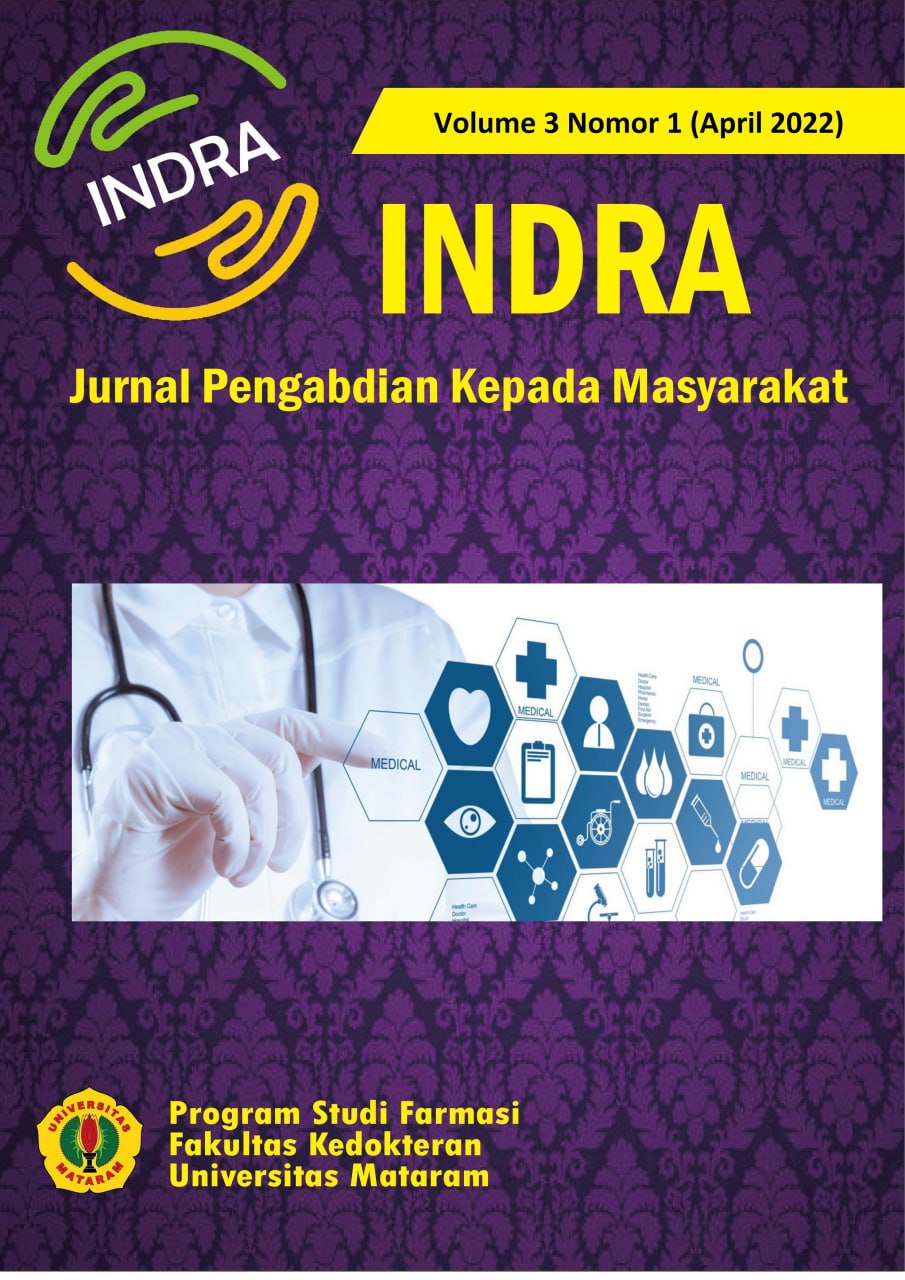Optimalisasi pencegahan dan penanggulangan stunting di Desa Sungai Tuan Ilir
DOI:
10.29303/indra.v3i1.160Published:
2022-04-30Downloads
Abstract
Stunting is one of the chronic nutritional problems which is still an important problem in Indonesia. Lack of nutritional intake in the first 1000 days of life or lack of nutritional intake for a long time is the main cause of stunting. Indonesia is one of the developing countries with more than half the number of children experiencing stunting. The prevalence of stunting is in position 115 out of 151 countries in the world. Banjar Regency is ranks third out of 13 regencies/cities in South Kalimantan which is children experiencing stunting at 48.2%. Through community service activities by conducting stunting prevention and control programs is hoped that there will be an increase in community knowledge and attitudes in the family environment. The focus targets of this community service activity are families who have children under five and or couples of childbearing age in Sungai Tuan Ilir Village. The program is carried out in three stages, namely providing health education, interpersonal communication (KAP), and stunting prevention campaigns. The activities were carried out well according to the program planning that was made as evidenced by the increase in community knowledge and attitudes both during the mass counseling process and during KAP activities and stunting prevention campaigns in the family sphere.
Keywords:
Prevention, Treatment, StuntingReferences
Giffin, K. (1967). The contribution of studies of source credibility to a theory of interpersonal trust in the communication process. Psychological Bulletin, 68(2), 104.
Hamzah, S. R., & B, H. (2020). Gerakan Pencegahan Stunting Melalui Edukasi pada Masyarakat di Desa Muntoi Kabupaten Bolaang Mongondow. JPKMI (Jurnal Pengabdian Kepada Masyarakat Indonesia), 1(4), 229–235. https://doi.org/10.36596/jpkmi.v1i4.95.
Hidayah, N., & Marwan, M. (2020). Upaya Pemberdayaan Masyarakat Dalam Menciptakan Generasi Milenial Sadar Gizi Yang Bebas Stunting Melalui Kegiatan 1000 HPK. Journal of Community Engagement in Health, 3(1), 86–93. https://doi.org/10.30994/jceh.v3i1.41.
Hitman, R., Samsuddin, Hidayatullah, R., Jumaidil, A, A. N., Salmia, Fitri, A., Masita, S. M., Amanda, E. P., Reskiah, N., & Maming, K. (2021). Penyuluhan Pencegahan Stunting pada Anak (Stunting Prevention Expansion in Children). Communnity Development Journal, 2(3), 624–628. https://journal.upy.ac.id/index.php/lppm/article/view/642.
Januarti, L. F., Abdillah, A., & Priyanto, A. (2020). Family Empowerment Model in Stunting Prevention Based on Family Centered Nursing. STRADA Jurnal Ilmiah Kesehatan, 9(2), 1797–1806. https://doi.org/10.30994/sjik.v9i2.536.
Kementrian Kesehatan. (2020). Situasi Stunting di Indonesia. Jendela Data Dan Informasi Kesehatan, 208(5), 1–34.
Khusna, N. A., & Nuryanto, N. (2017). Hubungan usia ibu menikah dini dengan status gizi Balita di Kabupaten Temanggung. Journal of Nutrition College, 6(1), 1–10.
Kim, S.S, Nguyen, P.H., Yohannes Y, et.al. (2019). Behavior Change Interventions Delivered through Interpersonal Communication, Agricultural Activities, Community Mobilization, and Mass Media Increase Complementary Feeding Practices and Reduce Child Stunting in Ethiopia. The Journal of Nutrition Community and International Nutrition. https://doi.org/10.1093/jn/nxz087.
Norcahyanti, I., Pratama, A. N. W., & Pratoko, D. K. (2019). Upaya Pencegahan Stunting dengan Optimalisasi Peran Posyandu Melalui Program Kemitraan Masyarakat. Dedication : Jurnal Pengabdian Masyarakat, 3(2), 73–80. https://doi.org/10.31537/dedication.v3i2.234.
Paramashanti, B. A., Paratmanitya, Y., & Marsiswati, M. (2017). Individual dietary diversity is strongly associated with stunting in infants and young children. Jurnal Gizi Klinik Indonesia, 14(1), 19–26.
Riset Kesehatan Dasar. (2022). Prevalensi Stunting Kal-Sel. In Balitbang, Kemenkes RI.
Riset Kesehatan Dasar. (2018). Hasil Utama Riset Kesehatan Dasar (RISKESDAS). Journal of Physics A: Mathematical and Theoretical, 44(8), 1–200.
Siswati, T., & Olfah, Y. (2020). Kampanye Cegah Stunting, Bangsa Sehat Sejahtera. Jurnal Bakti Masyarakat Indonesia, 3(1), 92–99. https://doi.org/10.24912/jbmi.v3i1.7984.
Starkweather, C., Guarino, A., Bennion, N., et.al. (2020). An interpersonal nutrition campaign and maternal knowledge and childhood feeding practices: a case study from mothers in rural Indonesia. Archives of Public Health. https://doi.org/10.1186/s13690-020-00444-9.
Titaley, C. R., Ariawan, I., Hapsari, D., Muasyaroh, A., & Dibley, M. J. (2019). Determinants of the stunting of children under two years old in Indonesia: a multilevel analysis of the 2013 Indonesia basic health survey. Nutrients, 11(5), 1106.
World Health Organization & United Nation Children Fund. (2018). Levels and trends in child malnutrition. eSocialSciences.
Young, M. F., Nguyen, P. H., Gonzalez Casanova, I., Addo, O. Y., Tran, L. M., Nguyen, S., Martorell, R., & Ramakrishnan, U. (2018). Role of maternal preconception nutrition on offspring growth and risk of stunting across the first 1000 days in Vietnam: A prospective cohort study. PLoS One, 13(8), e0203201.
License
Copyright (c) 2022 The Author(s)

This work is licensed under a Creative Commons Attribution 4.0 International License.











